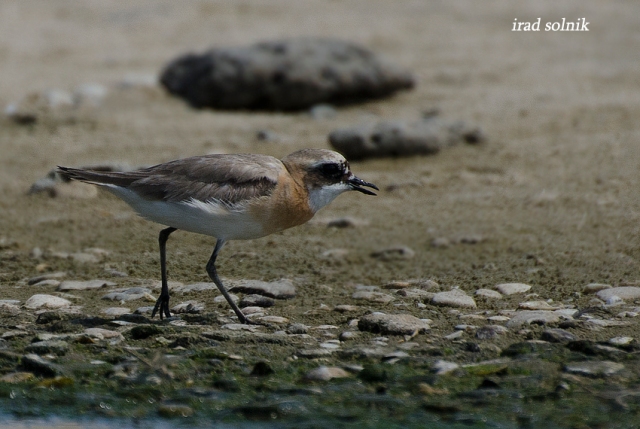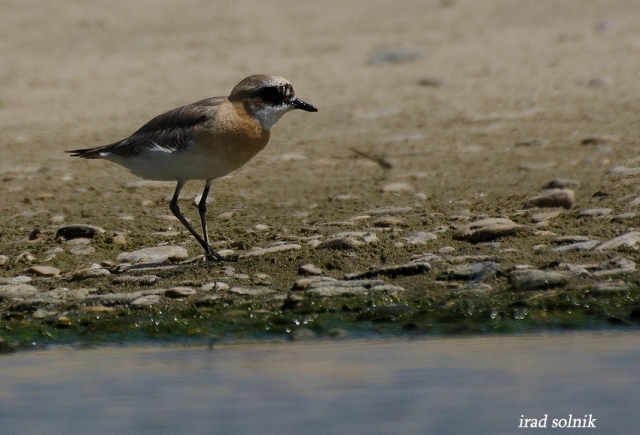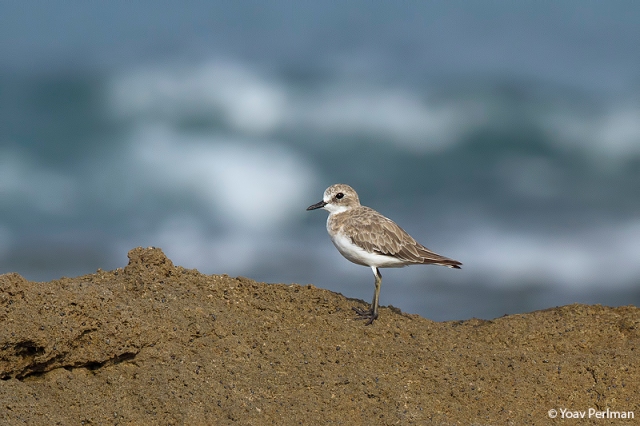Yesterday, Israeli birder Irad Solnik had a summer-plumaged sand-plover in a small lagoon near Bet Yanay, on the Mediterranean coast. This immediately got the alarm bells ringing, as Greater Sand-plover, which is common in Israel, moults very early and now is already in full winter plumage, while Lesser and Mongolian Sand-plovers moult much later and still are in summer plumage now (see this bird from Scotland a couple of weeks ago).
Surprisingly, both Lesser and Mongolian Sand-plovers are great rarities in Israel (they are common winter visitors to the Persian Gulf and Red Sea coast of Egypt), so I asked Irad to try and get some images of the bird. He returned to the site around midday and got these excellent shots, in very contrasting light.
It took me some time until I got to see the images on a computer screen (never try to identify birds on your mobile screen!) but eventually, after circulating the images among some top Israeli birders, we decided it was a small columbinus Greater Sand-plover. Thank god – my wife would have killed me (again) if I disappeared this morning to twitch a Mongolian Plover.
columbinus is the smallest and most delicate race of Greater Sand-plover, breeding in the Middle East (steppes of Turkey, Syrian and N Jordan) and W Asia, and the commonest race in Israel. The much larger and more massive crassirostris is rare in Israel. Most columbinus are still easy to identify, but some, like this small (female?) sand-plover can be quite tricky.
The black forehead and what looked like black legs, combined with summer plumage in late July were misleading. This is how adult columbinus should look like this time of year – this image was taken by myself on Wednesday – green legs!
But what eventually gave this bird away as columbinus were:
- Structure – though rather small (compare with Dunlin), this is still a powerful bird, not compact and delicate like lessers. Note especially the attenuated rear – lesser have much less ‘body’ behind the legs, and it seems that most of their mass is in front of the legs.
- Bill structure – the bill is long and quite thin. Lessers have a short and stout bill, and together with a rounded head give a cute impression. These in-hand images of Lesser Sand-plover were taken while ringing in Kenya in 2010 with A-Rocha Kenya.
- Leg structure – long tibia. Most lessers have a shorter tibia, but note that southernmost atrifrons lessers have pretty long legs and are frustratingly similar to columbinus – they overlap in almost every biometric parameter.
About leg colour – this feature must be used with great caution. Like most shorebirds, sand-plovers too get their legs covered in mud, sand, algae etc., and often true leg colour is impossible to tell, just like the Israeli bird.
And a few words on moult – in most long-distance migrants moult patterns are rather uniform and well defined. But there are always exceptions to the rule, like this bird. In this case, moult is a good indicative feature, not a clincher.
Thumbs up to Irad for noticing this interesting bird. BTW Irad is very hot lately – he found the first of the two Yellow-billed Storks present now in Israel. Many thanks to Irad for allowing me to use his photos.












i give up….moult and structure would make this a Lesser/Mongolian for me….
I agree with James. Surely this is an atrifrons Lesser.
I too give up on these if this is a Greater – I wouldn’t have given it a second glance as a Lesser-type if I had seen it at home here in Malaysia…
Back to the drawing board!
I agree. Hopefully good news and no shame for that most tricky of species pairs and ID’s but this looks like a straightforward ‘atrifrons group’ Lesser Sand Plover- probably a moulting male. Will dig out notes etc glad you posted! Martin
thanks yoav ..by the book i wase sure its a leschenaultii because i never seen one but the birds in the pics here held by hend are muce larger then the one i saw …in my opinion its mongolus but im not an exspert! end im bayos..sorry for my teribal misspell
I would love to see the places where the photos were taken. I’ve been thinking of going to Israel for a bird trip. I bet the raptors are great.
it was in the delta of Alexander river ..its a small pond with a small creek …i will be heppy to gaide some birders here,find me on facebook
I’m glad others have got here before me. No question in my mind that this is Lesser.
Pingback: Revealed: Mongolian Plover – First for Israel | Birding Frontiers